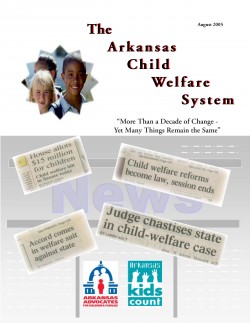
Historically, changes in Arkansas’ child welfare system have been closely tied to high profile incidents of severe abuse or deaths in cases involving child maltreatment and the resulting public and legislative responses to these events. It has been more than 10 years since the Arkansas child welfare system received widespread public attention for such abuses and was placed under court oversight as part of the Angela R lawsuit. That case documented the state’s violation of federal law and its failure to protect children in the state’s child welfare and foster care system. The court found extensive problems with the quality of abuse investigations, child safety, health care, foster home recruitment, staff and foster parent training, and services to families. The court eventually reached a settlement agreement with the state that took effect on January 1, 1992 and required major reforms of the system and a major increase in child welfare funding.
In response to the Angela R case, a special legislative session was called to deal with the concerns raised by the court. As a result, the DHS Division of Children and Family Services (DCFS) received $15 million annually in additional revenues and had to document a multitude of court imposed indicators to track its progress in protecting children and preserving families. The Child Welfare Oversight Committee was established to monitor DCFS compliance with the court ruling and to report findings to the legislature until 1994. Act 1222 of 1995 then mandated that DCFS provide quarterly performance reports to a legislative Joint Committee on Children and Youth using these same compliance indicators. That oversight continues today with presentations of the DCFS quarterly performance reports to the committee.
The court removed itself from the case in 2002, leaving oversight responsibility to the legislative and executive branches. Legislative concerns and frustration with the current methods of ensuring child safety led to the creation of the Crimes Against Children Division (CACD) within the Arkansas State Police in 1998. CACD was given responsibility for the 24 hour crisis hotline and for investigations of the most serious (priority-one) maltreatment cases. It was a state child welfare structure unique only to Arkansas. Despite this change, the primary responsibility for child welfare services remains with DCFS.
As part of a recent effort to improve its services to families, DCFS received a 2004 accreditation from the Council of Accreditation for Children and Family Services, a national group that establishes additional accountability measures to monitor the progress of state agencies in meeting child welfare certification standards. After more than a decade of outside oversight, DCFS has created a wide array of standards and compliance measures to ensure Arkansas children are safe and families are provided services to address the problems that cause child maltreatment.
What impacts have these changes on the child welfare system? Using 2000 – 2004 data from DCFS, this report assesses the progress that has been made (or not made) in reforming the child welfare system and the impact that policy and programmatic changes have had on families who are involved in Arkansas’ child welfare system. At best, the data is mixed. Improvements in the quality of staff training, the timeliness of investigations, child health assessments, and other factors indicate that children are safe and services have improved. However, many serious problems continue to plague a service delivery system that is high stress, short on resources, has high staff turnover, and deals with very difficult family situations.
